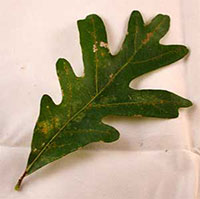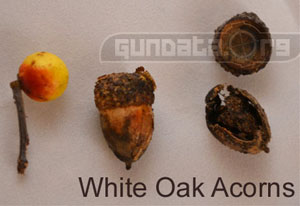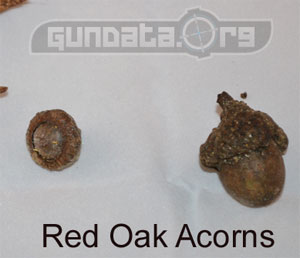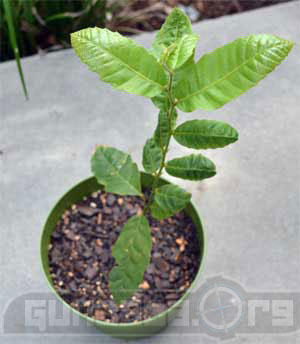Red Oak Acorn vs White Oak Acorn vs Chestnuts as Deer Mast
Article Posted: August 26, 2014
If you are a deer hunter with internet access you've likely spent dozens or even hundreds of hours researching mast crops for deer online. At some point in time you've skipped passed corn, soybean, brasica, and focused on planting a long term solution. A solution that will outlast even perennials like ryegrass and some clovers. A food source able to provide food even when you don't feel like shelling out the $10+ for a bag of corn. There really is only one solution...trees.
A good tree like a White or Red Oak and even a chestnut hybrid will provide food for your deer herd for decades and possibly even centuries. Granted there are other tree options like apples, persimmons, and even pears, but today we will be focusing acorns and chestnuts.
What this article is: This article is meant to display all the common knowledge in regards to oaks,and chestnuts. We will also provide some common sense tips that may save you time and money.
White Oaks

White Oak Leaf
As any good deer hunter can tell you white oak acorns are the preferred food source for deer "when they are falling". They have lower tanin levels making them less bitter than the red acorns. White oaks are kinda like the blackberry of the acorn world. They are an amazing crop but only last a few months both because they are usually eaten so quickly and the fact that they have less tanin means they will rot quicker. If you want to hunt using white oaks the best bet is to find one and not plant one as they will take years or decade before they will begin yielding a harvest. Identification: There are all sorts of names for species of white oaks. The main identifying factors are the rounded leaf tips, and the whiter/lighter bark.
Visit this page for a list http://en.wikipedia.org/wiki/List_of_Quercus_species
White Oak Pros

White Oak Acorns In Various Stages of Growth & Decay
- Low In Bitter Tanins
- Hardy once it reaches "adult stages"
- Deers #1 Favorite Healthy Snack
- White oak acorns are less bitter and mature in three months, one growing season. (ref)
White Oak Cons
- Only produce good crops one out of 4 years, and sadly no one knows why.
- Low tanic acid content means they will rot once they hit the forest floor.
Red Oaks

Red Oak Acorns - Notice Very Little Decay
Red oak acorns are the second choice of deer because they have higher tanin (tanic acid) content making them taste bitter. This tanic acid does however prevent the acorn from rotting so quickly. This means that the acorn provide better year long food sources for your herd. Find a red oak and look under the fallen leaves near any time of the year and you will likely find acorn that have not yet rotted.
Identification: Red oak leaves have sharper points, and the bark is darker and more rough (especially as the tree ages) Again there are all sorts of name for individual red oaks.
Red Oak Pros
- High tanin count means acorns are rot resistant.
- Hardy once it reaches "adult stages"
- Great for turkeys too.
Red Oak Cons
- Bitter because of higher tanic acid count.
- Takes 15 mo for the acorns to mature and fall.
Chestnuts

One of dozen or so Chestnuts we are growing for our grove.
Oh the American Chestnut tree. According to story the American Chestnut tree was the prefered mast crop for most every eating animal. However chestnut blight was brought over with the chinese chestnut and has pretty much eradicated the chestnut. Hybrids have now been made and marketed. The American/Chinese hybrid chestnut tree is shorter and the nuts have more tanin than the original American trees. Don't worry though just because it says "Chinese" doesn't mean the branches break off after a year or two. :)
Marketing: There has been tons of marketing pushing chestnuts lately. We even bought some dunstans and planted them ourself. These new trees are said to produce nuts after just 3 to 5 years, and they grow fast.
Chestnut Pros
- Produce a crop every year.
- Hardy once it reaches "adult stages"
- Great for roasting and eating
Chestnut Cons
- Chestnut blight may kill non hybrid trees.
- Deer may no longer be familiar with this nut.
Best Mast Crop?
So which is the best...the white, the red, or the chestnut? The answer is simple. The best tree is the one you don't have. Look around your land and identify your trees. If you have white and red oaks then you might want to make room for a small chestnut grove. If you only have red oaks then you might want to plant both white oaks and chestnuts. If you have white and reds then plant a few chestnuts. Having all three will make your deer herd healthier and and larger in both size and numbers.
What if you only have room for 1 species? If limited by acreage and you can only plant a few trees? This is a tough question to answer. Deer in your area most likely have no clue what a chestnut is due to it's rarity, and white and red oaks take a long time to produce and when they do produce they do so every few years. We are not sure what the answer to this question is so please let us know in the comment section below what you think the best mast tree is. Thanks for reading and please be sure to share and like this article.
Related Articles
Please like, share, favorite, bookmark, and comment. Thank You.
Original Articles
- New 25+1 Capacity Shotgun!
- Hudson H9 American Made 9mm
- How To Build A Mud Hut
- Pistol Looks Like Cell Phone
- 45 ACP vs 9mm Luger
- Best 9mm Carbines
- Mall Ninja Xtreme Zombie Carbine!
- 5 Alternative Range Bags for Pistols
- Best 45 ACP Carbines
- 5 Dirt Cheap Guns $170 to $260
- Muslim Free Shooting Range?
- How To Clean A Rifle
- 3 Good 300 AAC Blackout Reviews
- Top 5 Guns for Women
- How to Really Shoot A Pistol
- Worlds Best 9mm Handgun
- 5 Great Gun Safes (Options)
- 9mm vs 40 S&W Summary + Ballistics
- Red Oak, White, or Chestnut for Deer Herd?
- Bullets for Barter Post Collapse
- Funny Pro Gun Sayings
- 5 Strange Handguns You Don't Need
- 3 Great .22LR / 410 Survival Rifles
- American Rifles | The Original ARs
- 600 Round Glock Magazine
- 10mm vs 40 Summary and Ballistics
- How Important is "Shot Placement"?
- 10 Item First Aid Kit Checklist
- 10 Gun Lights for Home Defense
- How to Make a Stove Hobo Style!
- Most Basic Survival Food List Ever
- Best Handguns for Women
- Make Homemade Mosquito Trap
- Lets make a Sawed-Off Shotgun!
- Man Brings Knife to Gun Fight (Funny)
- Gun Store Etiquette (Proper vs Improper)
- 10 Simple Home Security Tips
- SIG-Sauer vs Glock
- Legal Length of Shotguns and Rifles
- 9mm Pocket Pistols
- Glock 17/19/26 Operating Procedures
- 10 Conceal Carry Tips (Funny)
- Understanding the 2nd Amendment
- Choose Your Own Crime Stats
- After You Dial 911 : Dont Be A Victim
- Does Gun Control Work?
- Best Shotgun Ammo for Self Defense
- Best Calibers for Self Defense
- FBI Handgun Ballistics
- 38 Special vs 380 ACP
- Top 5 Home Defense Handguns
- 5 Best Home Defense Shotguns
- How to Sight in a Scope - Step by Step Guide
- .380 ACPs Stopping Power (Funny)
- AK-47 vs AR-15 History and Facts
- A Bug Out Bag Checklist for 2015
- 30-06 vs. 270 Win
- Gun Stores
Ballistics Tools & Data
- Ballistic Trajectory Calculator
- Ballistic Coefficient Calculator
- 9mm Ballistics Chart
- 308 Ballistics Chart
- 30-06 Ballistics Chart
- .270 Win Ballistics Chart
- 30-30 Ballistics Chart
- 7.62x39mm Ballistics Chart
- 7mm Rem Magnum Ballistics Chart
- 17 HMR Ballistics Chart
- 223 Ballistics Chart
- .243 Ballistics Chart
- 22-250 Ballistics Chart
- Convert FPS to MPH









